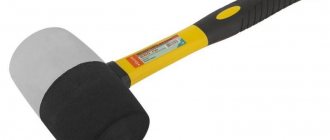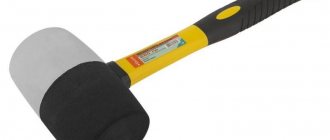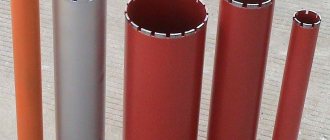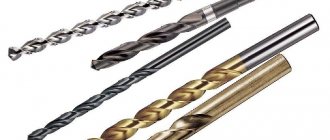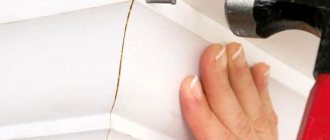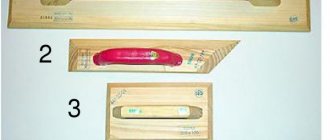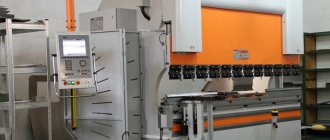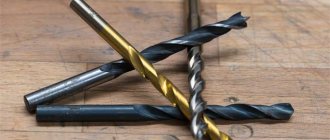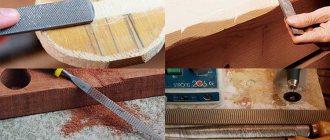Purpose
Whatever object you use: a semi-automatic table for cutting glass or a manual device, the essence of their functioning is the same - applying a direct scratch to the surface, along which a break occurs manually. In addition to glass, popular models successfully cope with tiles, ceramics, and corrugated glass bases.
When working with corrugated glass, the cut is made from the smooth side. It is not recommended to cut tempered glass. The slightest damage leads to their disintegration into tiny particles.
Roller version
A roller glass cutter is the most common and popular type of tool among amateur glaziers. It is quite simple and easy to use. The design of this tool includes 1-6 cutters with rollers made of steel or tungsten carbide. The diameter of the wheel is 6.6 mm. Used for cutting glass with a thickness of 1-5 mm. Can process up to 350 m of glass sheet before dulling. The roller glass cutter is best suited for household use.
Description and characteristics
The simplest devices have the following structural elements:
- handle with tube (connecting rod);
- a head that visually resembles a hammer;
- mandrel with cutting working element.
Based on the type of head mounting, the following types are distinguished:
- Rotating mandrel capable of drawing curved lines.
- Fixed plan tool.
The cutting element is an artificial diamond crystal. There are two versions of the crystal, differing in shape:
- A cutter with a curved surface.
- A cutter resembling a four-sided regular pyramid in shape.
Models with such cutting elements are usually called diamond. If the device is equipped with rollers for cutting, then they belong to the roller category.
The classic version is that the head has one or more grooves of varying widths. There are popular models with grooves on a small bar attached to the shaft of the handle. Thanks to such recesses, the glass edge breaks off. The grooves help remove excess material if the break does not occur at the marking site. You can also use special forceps or pliers.
Manufacturing materials
When making the handle the following is used:
- phenoplast;
- polystyrene;
- dense tree species;
- other materials with similar mechanical properties.
The remaining structural elements (with the exception of the diamond cutter) are made of alloys and metals:
- Hammer and rod - steel or brass.
- The holder is high quality steel.
- Aluminum base.
The working elements are made of synthetic or natural diamond, and the first option is practically not inferior in its characteristics to its natural analogue. The carbide cutter is made from pobedit, the carbide rollers are made from cobalt-tungsten alloys.
Options
The standard dimensions of the product are as follows:
- length – 120 mm;
- thickness – 88 mm;
- width – 30 mm;
- weight ranges from 20 to 100 g.
A pyramid-shaped cutter is 22 mm long, curved - 16 mm, in accordance with GOST.
The maximum glass thickness for a natural diamond to function is 10mm. The rollers in the models of the same name have different diameters, however, 6.6 mm are considered the most common and in demand.
Other parameters:
- cutting depth (max) – 5 mm;
- sharpening angle – 100 degrees.
There are models with an oil cooling function for the rollers, a sharpening angle of 150 degrees (used for cutting thick material of 20 mm) and 135 degrees (works with a maximum thickness of 10 mm).
Resource and marking
Manufacturers provide a one-year warranty on even the best models from the date of sale. However, there are other indicators. Thus, the diamond device is capable of cutting up to 12,000 linear meters. material. As for roller types, the maximum resource is 350 m.
Diamond tool markings indicate the orientation of the working edge. Products intended for import have diamond chips applied, the weight of which is indicated in carats. The manufacturer's own trademark is engraved on the hammer. The best manufacturers participating in the rating of quality products apply appropriate markings to the product.
GOST
GOST 10111-85 has been introduced for diamond glass cutters.
According to it, the instrument is accompanied by documents indicating its symbol, the manufacturer's trademark, the weight of the diamond, the date of manufacture, as well as a stamp confirming the passage of technical control.
Standard developed in the Soviet years: GOST 4407-72
Job resource
From the date of sale, the warranty period for the glass cutter is 1 year, that is, the warranty is provided by the manufacturer itself.
At the same time, up to 12 thousand linear meters of material can be cut using a diamond tool, while the rollers are designed for a cutting length of at least 350 meters.
Marking
Diamond cutters are marked to indicate the orientation of the working edge.
On independent products intended for import, the weight of the diamond (in carats) is additionally applied.
The instrument's hammer itself bears the manufacturer's trademark.
All manufacturers of quality tools also put proper markings on them.
What are there
Tools differ in design features, and therefore they are divided into the following types, the differences between which are indicated in the comparative table:
| Varieties | Description |
| Diamond | The working element is a natural or synthetic diamond crystal. During operation it gradually wears out. Available in two types: the curved cutting edge is more suitable for beginners, while the pyramidal shape is preferred by professional glaziers. In case of minor wear, grinding on a block using mastic with diamond dust is possible. Maximum resource – 10,000 linear meters. The average price is 1500 rubles. |
| Pobeditovye | Roller models, the cutter is made of pobedit. Visually no different from the previous version, but at a lower price. The functionality is not so extensive. Used for domestic needs, and even then rarely. The main disadvantage is the rapid dulling of the carbide cutter, which results in a poor-quality groove. Reviews about the product are negative. |
| Roller | They are popular among both beginners and professionals. The cut is made using a rotating roller. Specialty stores offer a choice of options with six, three and one roller. Rarely, there are two-roller ones with a plastic body. Refers to budget options. Tools with a steel wheel are sold at a price of 700 rubles, the most inexpensive with a minimum resource can be purchased for 90 rubles. |
| Oily | A roller model equipped with a small reservoir for filling oil that gets onto the cutting element during operation of the device. A hollow handle is often used as a reservoir. It has a long service life and smooth movements. Resource – 5000 linear meters with a maximum material width of 20 mm. The product is sold at a minimum price of 160 rubles. |
| Glass cutter - compass | Used for cutting out round shapes. Based on a circular mechanism. A suction cup acts as a support, thanks to which the tool is attached to the surface. Other structural elements: cutter and scale. |
| Circular | Designed for cutting ovals. Thanks to two centers, it is possible to move along a complex trajectory. The cost exceeds 1000 rubles per unit. |
| Special | Used to produce glass circles with a minimum diameter in industrial quantities. The appearance is original - a flat design with a rod and a cutter equipped with locking elements to avoid shifts. There is a convenient “L”-shaped handle. |
Oil version
The operating principle of an oil glass cutter is similar to a roller cutter. Its main feature is the presence of a lubricant flask on the handle. The automatic supply of oil to the moving wheel helps reduce friction and increase its service life. Designed to work with glass up to 20 mm thick. Requires complete replacement of the roller after cutting 6 km of material. For efficient and accurate operation of an oil glass cutter, it is important to choose the right lubricant for it; it is better to use oil from trusted manufacturers.
How to choose
Specialized retail outlets offer a wide selection of products intended for cutting glass. On the shelves you can find new products from the world's leading manufacturers, leading the TOP of modern products and inexpensive Chinese-made options with minimal resources. Where to buy and which company is better depends on the preferences of the master. However, there are basic selection criteria that must be taken into account in order to avoid mistakes when making the final decision:
- Thickness and type of material to be cut.
- Volume of work.
- Professionalism of the master.
- How much does the tool cost?
What to look for when choosing a tool for your home? Expert advice is as follows:
- If you need to assemble a furniture set, you should not look for an expensive industrial product, which tops the rating of high-quality tools used in large-scale construction of real estate.
- There is a large amount of work with inflated requirements, and there is no experience; it is better to turn to professionals for help. They work with their own tools and you can make a claim if a defect is discovered.
- When carrying out repairs, the main thing is to use convenient tools. Pay attention to the ergonomics of the handle. According to buyers, the most convenient are wooden options, which do not slip and fit comfortably in the hand. A device with a metal casing may have roughness and unevenness.
- Having your own experience working with various devices. If you preferred to use roller models, then you should not switch to diamond ones.
- Pay special attention to the quality of the videos. They shouldn't be loose.
- Which one is better to buy? Only high-quality and reliable product. Before paying for the goods, you should ask the sales manager to demonstrate the device in action. Pay attention to the cut parameters of oil and diamond tools. It should be very thin, almost invisible. Roller models should function quietly, without creaking, with a little crackling.
Before visiting construction markets, conduct a review of the products offered and select the best option. You can order goods from China using the Ali Express delivery service. Those who prefer to purchase devices in an online store can place an order online. This way you can save a little on the price of the product.
Features of glass structure
The first analogues of glass appeared more than 5,000 years ago. It is believed that Egypt was the birthplace of its production. They began to make baked bricks there. In the furnace, when the sand was overheated, nodules were formed; they contained oxides of silicon (SiO₂), barium (Ba₂O₃), calcium (CaO) and a number of other components that gave different color shades.
The original flowing flows were used as decorations. Users were attracted by their special properties:
- High hardness, there were no objects around that could damage the shiny surface. Metals of that period did not have such surface strength.
- For decades, the appearance has not changed. The fired structure of the material did not oxidize either in water or in air. The products made from glass materials were decorated with gold and silver jewelry.
- The shape of the glassy casting was not only spherical. As a result of the flow, unusual shapes were formed, reminiscent of people, animals, birds and body parts. Priests often used such objects when conducting services to various deities.
- Low-melting metals found in nature painted glassy objects in the most unusual colors and combinations thereof. As a result, sunlight was refracted in them in the most unexpected way. The play of refracted and reflected rays was not repeated even for products of the same shape.
Much later, they learned how to melt oxides of silica metals and subsequent cooling, which made it possible to obtain transparent glass or with different colors. Then they began to work out ways to cut and cut it.
Carrying out marks on a glass surface:
When characterizing the material, it is noted that the properties remain the same in all directions. The crystal lattice has not completely frozen. When heated to certain temperatures, plastic deformation is possible:
- Glass is afraid of sudden cooling, then surface tension (the temperature inside can be significantly higher than the outside) leads to instant destruction. The speed of crack propagation inside can reach values of 3000...5000 m/s.
- Hardening is a rather complex process in which heating is carried out only from the outside. The inner layer does not warm up. Cooling is carried out in air. The surface layer creates a pulling effect on the interior space. Therefore, tempered glass can withstand quite strong impacts.
- Of course, there are also critical values. Then the entire surface shatters into tiny particles. They continue to deteriorate for some time. You can watch how the broken tempered glass crumbles into dust for another 2…3 seconds.
- The material remains hard only externally. Studies have been carried out on glass installed 2…3 centuries ago. It turned out that the thicknesses at the top and bottom differ from each other. Every day, month, year, century, some molecules flow down from top to bottom. Interesting fact: the Moscow Kremlin has preserved windows that were installed during the reign of Ivan III (late 15th - early 16th centuries, 500 years have passed). When we measured the thickness of the glazing, we found: the difference between the upper and lower values reaches up to 1.5...1.7 mm (when installed, the thickness was 8 mm).
- When applying marks with a depth of only 0.0002...0.0004 mm, a critical zone is formed along which fracture is possible. It is this ability to destroy the integrity of the product that forms the basis for cutting glass using glass cutters. Attention! If the fracture is not made within several hours after its application, then an influx of glassy mass occurs. A subsequent attempt to break the glass may be unsuccessful. The crack will go away from the risk.
- The researchers note that applying a mark to the surface of the material from a glass cutter produces another important effect: local heating of the surface occurs. Therefore, between applying the risk and breaking it, you need to try to complete the destruction as quickly as possible. Then the edges of the cut will be most accurate.
- Chemical glassware is made of glass. It is inert to all alkalis and most acids. Only hydrofluoric acid can dissolve, but in real conditions the presence of this substance (HF) is practically not noticed. The transparency of chemical glassware is an important plus. You can observe the passage of chemical reactions through the walls.
- A special scale is used to characterize the hardness of glass-like materials. It was named after its author, Friedrich Mohs (a German mineralogist and geologist who studied the properties of precious stones, researched processing and cutting technologies). Using the Mohs scale, materials are selected that can cause marks on glass and other materials to be processed.
Items are arranged according to the Mohs scale. The hardness value is in parentheses.
Rules for working with the tool
The efficiency of working with a glass cutter and the production of a minimum amount of waste directly depends on the correctness of the actions. Let's look at the main nuances:
- The glass is pre-cleaned and dried, placed on a flat horizontal surface, covered with a piece of thick fabric for softness.
- A cutting plan is prepared and depicted on a sheet of paper.
- Take a ruler or template and press it tightly to the sheet.
- The glass cutter is held by the base of the handle.
- A line is drawn without pressure, starting from the far edge. Using a diamond model, you will get an almost invisible feature. Roller ones will make a deeper groove. The action is performed once. If a mistake is made, the sheet is turned over and a line is drawn on the other side.
- The final stage is surface fracture. Made with gloves. To simplify the process, tap the back of the sheet lightly with a mandrel. The sheet is laid on the table so that the cut line coincides with the edge of the tabletop. A sudden movement should lead to a high-quality break.
- The smoothness of the edge is ensured by a special drill with a sharpening attachment clamped in a chuck. Work is carried out exclusively in protective glasses.
Radius option
The radius glass cutter is used for cutting round or oval shapes. Most often used in production. It consists of a fixing suction cup, a ruler and a cutting roller (1-6). Some models are equipped with automatic lubrication, and those without this system are lubricated during operation. Used for cutting glass with a thickness of 4-10 mm. The diameter of the cut circles is 8-180 cm.
How to use a glass cutter:
- A prepared sheet of glass is laid out on the work surface.
- A radius glass cutter is installed in the center on the suction cup.
- Using the ruler scale, the required radius is set.
- The cutting roller draws a circle.
- Lightly tapping the hammer removes the cut out circle.
Rating of the best glass cutters for 2022
Diamond
FIT 16932
Found application in the professional sphere and at home. Designed for cutting glass surfaces. Suitable for stained glass. It has a significant service life of 4500 m. The diamond component is subject to sharpening, which increases quality and accuracy. High-quality tool steel was used in the manufacture of the holder. The handle is made of wood.
The average price is 306 rubles.
FIT 16932
Advantages:
- great resource;
- quality;
- ease of use;
- reliability;
- high speed;
- build quality.
Flaws:
- significant ones have not been established.
Kraftool Silberschnitt 33677
Oil device. The cutting part is made of tungsten carbide. The main difference is noteworthy strength and reliability. Nickel-plated steel was used in the manufacture of the head, the handle is brass, and there is an abrasive coating. Works with material 12 mm thick.
The average cost is 3129 rubles.
Kraftool Silberschnitt 33677
Advantages:
- resource 50000 m;
- effective;
- professional;
- comfortable handle;
- oil is supplied automatically;
- cutting accuracy;
- complete with case;
- strength of the manufacturing material.
Flaws:
- significant cost;
- there are no grooves for breaking glass;
- It is difficult to determine the amount of oil in the container.
Russia 87225
The product of the Russian manufacturer has good characteristics and an affordable price. The head is steel, chrome plated, the handle is made of plastic. Weight – 0.3 kg. Cutting depth – 5 mm maximum. Works great on window glass.
Retailers offer products at a cost of 217 rubles.
Russia 87225
Advantages:
- high strength;
- comfortable to hold;
- long service life;
- convenient to use.
Flaws:
- the large size of the head obscures the full view;
- Only a straight, figured cut does not work out well.
Brigadier Extrema
Enjoys well-deserved popularity among professional glass cutters. Tops the TOP diamond models. In the production of the head, hardened steel was used, the handle was wooden, opened with varnish. The cutting is carried out with synthetic diamond. Product length – 180 mm. The case is equipped with special grooves that allow high-quality breaking off of the edges.
The average price is 524 rubles.
Brigadier Extrema
Advantages:
- reliable fixation of the cutting element;
- excellent functionality;
- easy to use;
- evenness of the cut;
- functions in any direction;
- long service life;
- safety.
Flaws:
- the handle slides;
- Storage is provided exclusively in a case;
- significant price;
- The handle may break if pressed too hard.
FIT 16930
The development is Canadian, produced in the Middle Kingdom. A distinctive feature is the presence of industrial diamond at a certain angle. Used for cutting material 5 mm thick. The manufacturer provides 5 grooves for high-quality breaking of surfaces with different sections. The wooden handle fits comfortably in the hand.
Product price – 421 rubles.
FIT 16930
Advantages:
- quality of work;
- significant strength;
- large resource - 50,000 m;
- comfortable to hold;
- can be used both for domestic needs and in production;
- quality grooves;
- durability;
- excellent combination of price and quality.
Flaws:
- small depth of cut;
- weak diamond fixation;
- Possibility of grinding wooden handle.
Roller
FIT 16921
The Canadian company has launched the production of high-quality glass cutters with noteworthy functions. A durable steel head and a special screw make it possible to ensure high-quality fixation of the axis position. The plastic handle is equipped with special grooves for ease of holding with your fingers. Brass inserts minimize the possibility of the device slipping out. The maximum cutting depth is 8 mm.
The average price is 451 rubles.
FIT 16921
Advantages:
- excellent cutting ability;
- The oil flask is transparent, which allows you to control its volume;
- easy to use;
- used for professional purposes;
- anti-corrosion properties of the material;
- long service life;
- reliability.
Flaws:
- equipped with one roller;
- possibility of breakage of the plastic handle;
- the head is fixed poorly;
- needs a special storage case;
- overpriced.
Bohle Silberschnitt
An excellent German model for professional work. Single-roller device with a service life of up to 5000 m. Maximum cutting thickness – 6 mm. Enjoys authority among experienced glass cutters.
The average cost is 375 rubles.
Bohle Silberschnitt
Advantages:
- comfortable handle;
- comfortable to use;
- excellent cutting qualities;
- reliable;
- high-quality assembly;
- made of quality material.
Flaws:
- one roller;
- lack of grooves for breakage;
- the worn disk is not changed, the tool is thrown away.
Sparta 872235
A budget option for a Chinese glass cutter. There is a drum with six spare rollers. A small supply involves cutting only 300 m of glass. Metal head, wooden handle. Cutting depth – up to 5 mm.
The average cost is 214 rubles.
Sparta 872235
Advantages:
- combination of price and quality;
- The handle is held comfortably in the palm of your hand;
- ease of operation.
Flaws:
- the head may become loose;
- safety margin is insignificant;
- only straight movements;
- low quality model.
Truper CV – 5, 12953
Mexican all-metal tools differ from similar products in their significant strength, reliability and long service life. It is almost impossible to break or damage. Maximum cut – 8 mm. The handle has a special ball for tapping on the surface. The head is equipped with three grooves for breaking off small glass pieces.
The manufacturer offers the product at a price of 557 rubles.
Truper CV – 5, 12953
Advantages:
- reliability;
- durability;
- strength;
- small dimensions;
- inexpensive.
Flaws:
- long incisions are excluded;
- too light weight;
- the handle may slip and be uncomfortable to hold;
- not used for industrial purposes;
- poor quality of work.
Stanley 0 – 14 – 040
High-quality American device for cutting glass at home. It differs from analogues in the presence of six tungsten rollers. After one of them becomes dull, you can use the other by first turning the drum over. To avoid rust, the holder is plated with nickel. The varnished handle is made of durable wood.
The average cost is 689 rubles.
Stanley 0 – 14 – 040
Advantages:
- fits comfortably in the hand;
- does not slip out;
- comfortable;
- easy;
- durable;
- reliable;
- can be used as a tile cutter - pencil;
- excellent cutting characteristics;
- insignificant price.
Flaws:
- unable to handle large volumes;
- small incision depth - up to 4 mm.
Biber 55531
The tool is easy to use and efficient. There is a dispenser for refilling with kerosene or spindle oil, which makes this work quick and easy. Equipped with a carbide cutting element, giving it strength and durability. Weight – 0.05 kg, plastic handle, one cutting element, no circular function.
The average price is 178 rubles.
Biber 55531
Advantages:
- easy to operate;
- comfortable;
- qualitative;
- effective.
Flaws:
- no significant ones.
Matrix 87264
A small tool is able to handle different surface thicknesses, working at different angles. The hollow handle is designed for refilling with oil or kerosene. The cutting element is made of VK-8 (hard alloy). It only makes straight lines; there is no option to draw circles.
The average cost is 292 rubles.
Matrix 87264
Advantages:
- strength;
- durability;
- reliability;
- ease of use;
- light weight;
- effective;
- significant work resource;
- a specially shaped head that allows you to work at any angle;
- two-year warranty;
- optimal dimensions.
Flaws:
- significant ones have not been established.
Stayer Profi 33692
The German brand's oil roller model, however, is manufactured in China. Used for cutting glass surfaces with a thickness of 2 to 10 mm. It is practical and convenient. Thanks to the all-metal construction, it has a long service life.
The price of the product is 489 rubles.
Stayer Profi 33692
Advantages:
- the presence of a special dosed flask in the kit;
- durability;
- strength;
- convenient dimensions;
- spring-loaded head;
- roller version;
- used in industry and home use;
- reliability;
- significant resource.
Flaws:
- no significant ones.
Sturm 1077 – OL – 01
Roller oil device with oil supply reservoir built into the handle. High-quality impact-resistant material was used in the manufacture of the handle. Parameters: 235 x 62 x 14 mm, weight 0.06 kg. The brand comes from Germany, production is located in the Middle Kingdom.
The average cost is 166 rubles.
Sturm 1077 – OL – 0
Advantages:
- durable design;
- 25 month warranty;
- reliability;
- convenient product length;
- durable plastic case;
- efficiency;
- performance.
Flaws:
- no significant ones have been identified.
Circular
Circular Glass Cutter
For quality work, experienced glass cutters prefer to deal with professional devices, because mistakes cannot be made. There is only one attempt to cut a circle in thin glass or ceramic tile. Otherwise, you will have to purchase another sheet. Regular glass cutters are suitable for straight cutting. To draw a circle, you need to purchase a special device - a circular glass cutter.
Despite its simplicity, the design is very thoughtful. The metal ruler is equipped with a rubber suction cup, which is necessary for fixing it in one place. A glass cutter is mounted on the ruler, which moves freely along its entire length. Using the provided handle, the tool is fixed to a certain division of the ruler, the maximum length of which is 20 cm.
The product is sold at a price of 731 rubles.
Circular Glass Cutter
Advantages:
- used in both horizontal and vertical positions;
- works with surfaces of different thicknesses;
- easy to use;
- reliable;
- allows you to cut any configuration;
- optimal scale;
- used both at home and in industrial enterprises;
- light weight;
- convenient dimensions;
- safety.
Flaws:
- none.
Hasal 308.25/308.50
Professional compass – glass cutter with adjustable cutting angle. Cutting diameter – 95 – 500 mm. Widely used for cutting double-glazed windows. The product is manufactured by a world-famous Turkish company. It is distinguished by reliability, durability, and ease of use.
The average cost is 9758 rubles.
Hasal 308.25/308.50
Advantages:
- used on an industrial scale;
- long service life;
- safe;
- quality;
- efficiency;
- good combination of price and quality;
- significant resource.
Flaws:
- significant ones have not been established.
KD, art. BLD(R)
Professional hand tools are used for cutting large circles of 10 - 200 cm. Manufactured by a Chinese company. Equipped with a suction cup, square profile measuring rod, large capacity for cutting fluid. Works with glass thickness from 6 to 12 mm.
The average price is 4047 rubles.
KD, art. BLD(R)
Advantages:
- reliability;
- efficiency;
- long service life;
- safety;
- quality;
- significant resource;
- durable material;
- convenient to use.
Flaws:
- no significant ones were found.
Question answer
What kind of oil to pour into an oil glass cutter
The quality of the oil has a direct impact on the performance of the glass cutter. Therefore, the choice of product must be taken responsibly. A lubricated roller ensures smooth movement and collects glass dust. Using a lubricant extends the life of the tool.
To maintain an oil glass cutter, it is recommended to purchase special compounds. The recommended ones include:
- Milli M2000;
- Bohle;
- Novacan Cutter Oil;
- Acecut 5503;
- T-3133.
They have a special consistency, are easily removed from the glass surface, evaporate quickly, and do not spread. They are used, as a rule, when performing professional cutting, when the issue of chip quality is paramount.
Lubricant for the tool is selected taking into account the thickness and strength of the material. At home, it is enough to use Vaseline or spindle oil. The consistency of the composition should be liquid so that the cutter can easily follow the markings. The following options are considered as substitutes: kerosene, white spirit, turpentine. It is prohibited to use machine or sunflower oil for glass cutting.
Which side to cut a mirror with a glass cutter
To cut mirrors, both a regular roller glass cutter and a diamond type of tool are used. The main thing is that the cutting part is made of carbide material and is well sharpened.
The mirror cloth is laid on a flat surface. After this, make markings with a ruler and marker. Sliding with a glass cutter is performed in reverse. All actions are performed on the front side of the mirror (the one that provides the reflective effect). The passage of the glass cutter is carried out with a confident and fast movement.
Enkor 9391 – high-quality and inexpensive oil glass cutter with a durable roller
Enkor 9391 is an affordable, but good glass cutter with a high-quality roller that pushes a deep enough groove that allows you to break the glass exactly along the cut line. The metal handle has a textured surface , due to which it does not slip out of the palm, guaranteeing a reliable grip. Enkor 9391 is suitable for both straight and curved cutting . Lubrication is carried out automatically - oil is supplied to the roller from the inside of the handle. Reviews of the Enkor 9391 glass cutter left by customers indicate that this model is not inferior to its diamond counterparts .
Anchor 9391
Advantages of Enkor 9391
- durable textured metal handle;
- neat soft cut;
- automatic lubrication of the roller when cutting;
- high quality at an affordable price.
Disadvantages of Enkor 9391
- the cutting roller hangs a little in the groove (in some copies).
Price Enkor 9391 – from 260 rubles.
What is the best way to cut relief tiles?
For straight cutting or shaped cutting of porcelain stoneware and relief
For ceramic
tiles,
angle grinders (grinders) with a diamond disc are used.
Interesting materials:
How to preserve Chubuki grapes in winter? How to preserve gladioli after digging? How to preserve irises for planting? How to preserve irises for the winter? How to save a hyacinth bulb for next year? How to store sliced apples in the refrigerator? How to preserve harvested grapes? How to remove an old bolt? How to create a Moorish lawn? How to create a romantic evening for a girl?
